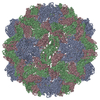+Search query
-Structure paper
| Title | Citrus sudden death-associated virus as a new expression vector for rapid production of heterologous proteins, chimeric virions, and virus-like particles. |
|---|---|
| Journal, issue, pages | Biotechnol Rep (Amst), Vol. 35, Page e00739, Year 2022 |
| Publish date | May 17, 2022 |
 Authors Authors | Emilyn E Matsumura / Fei Guo / Daan Boogers / Dennis van Oevelen / Sandra T Vu / Bryce W Falk /   |
| PubMed Abstract | The more we understand the strategies used by viruses for protein expression, the more possibilities we have to exploit viruses as expression vectors for heterologous protein production. Advances in ...The more we understand the strategies used by viruses for protein expression, the more possibilities we have to exploit viruses as expression vectors for heterologous protein production. Advances in the development of virus-based expression systems have been possible due to generation of many virus infectious clones, especially those derived from plant viruses, which have the capability for rapid and high-level transient expression of proteins in plant cells, a robust and low-cost bioreactor. In this work, we generated new replicative virus expression vectors based on a previously constructed citrus sudden death-associated virus (CSDaV) infectious cDNA clone. These vectors were generated to express the reporter green fluorescent protein (GFP) in leaves by taking advantage of the expression strategies used by CSDaV to produce its structural proteins. We show that higher amounts of GFP can be produced from a coat protein (CP)-independent CSDaV-based vector, compared to levels of GFP expressed from a widely used non-replicative vector (pEAQ series); or GFP can be produced in fusion with the major CSDaV CP (CPp21) to be incorporated into chimeric virions. However, GFP-recombinant CSDaV virions do not appear uniformly assembled, but more likely as mosaic particles. Cryo-electron microscopy analysis from this work revealed the structures of the wild-type and the GFP-recombinant CSDaV virions, but it was not able to reveal where exactly the GFP is displayed in the chimeric virions. We show though that the incorporation of GFP-CPp21 fusion protein into virions occurs solely due to its interaction with free/non-fused CPp21, independent of other viral proteins. Therefore, individual co-expression of GFP-CPp21 and CPp21 in the same plant cells leads to the production of chimeric virus-like particles (VLPs), while GFP-CPp21 fusion protein itself is not able to self-assemble into VLPs. The new CSDaV-based expression vectors may provide an alternative platform for use in molecular farming, either for production of heterologous proteins or as scaffold for heterologous protein display. |
 External links External links |  Biotechnol Rep (Amst) / Biotechnol Rep (Amst) /  PubMed:35646618 / PubMed:35646618 /  PubMed Central PubMed Central |
| Methods | EM (single particle) |
| Resolution | 3.1 - 3.4 Å |
| Structure data | EMDB-25397, PDB-7sqy: EMDB-25398, PDB-7sqz: |
| Source |
|
 Keywords Keywords |  VIRUS / VIRUS /  Capsid / coat protein Capsid / coat protein |
 Movie
Movie Controller
Controller Structure viewers
Structure viewers About Yorodumi Papers
About Yorodumi Papers







 citrus sudden death-associated virus
citrus sudden death-associated virus
